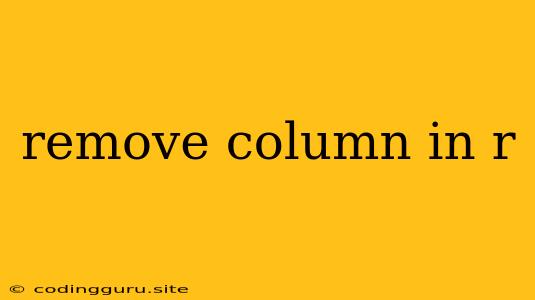Removing Columns in R: A Comprehensive Guide
When working with data in R, you'll often find yourself needing to manipulate your dataframes. One common task is removing unwanted columns, a process that's both simple and crucial for data cleaning and analysis. This article provides a comprehensive guide to effectively remove columns from your R dataframes, covering various scenarios and techniques.
Understanding the 'remove column in r' Concept
The core idea is to eliminate specific columns from your dataframe, essentially shrinking its size and focusing on the remaining relevant data. This can be achieved through several methods, each with its own strengths and considerations.
Methods for Removing Columns
1. Using the [ Operator
The most straightforward method involves using the bracket operator ([, ]) to select the columns you want to keep, effectively excluding the unwanted columns.
Example:
# Create a sample dataframe
my_data <- data.frame(
col1 = 1:5,
col2 = c("A", "B", "C", "D", "E"),
col3 = rnorm(5),
col4 = c(TRUE, FALSE, TRUE, TRUE, FALSE)
)
# Remove column 'col2'
new_data <- my_data[, c("col1", "col3", "col4")]
# Print the new dataframe
print(new_data)
In this example, we select columns "col1", "col3", and "col4", implicitly excluding "col2".
2. Using the subset Function
The subset function provides a convenient way to select specific rows and columns based on conditions. For removing columns, we can simply specify the column names we wish to keep within the select argument.
Example:
# Create a sample dataframe
my_data <- data.frame(
col1 = 1:5,
col2 = c("A", "B", "C", "D", "E"),
col3 = rnorm(5),
col4 = c(TRUE, FALSE, TRUE, TRUE, FALSE)
)
# Remove column 'col2' using subset
new_data <- subset(my_data, select = c("col1", "col3", "col4"))
# Print the new dataframe
print(new_data)
This method offers similar functionality to the bracket operator but might be preferred for its readability and explicit selection.
3. Using the dplyr Package
For more complex operations, the dplyr package provides a powerful and intuitive framework for data manipulation. Its select function allows for flexible column selection and removal.
Example:
# Load the dplyr package
library(dplyr)
# Create a sample dataframe
my_data <- data.frame(
col1 = 1:5,
col2 = c("A", "B", "C", "D", "E"),
col3 = rnorm(5),
col4 = c(TRUE, FALSE, TRUE, TRUE, FALSE)
)
# Remove column 'col2' using dplyr
new_data <- my_data %>%
select(-col2)
# Print the new dataframe
print(new_data)
The - sign before col2 indicates that this column should be removed.
4. Using the - Operator (Base R)
Similar to the dplyr approach, the - operator within base R can be used directly with the bracket operator to remove specific columns.
Example:
# Create a sample dataframe
my_data <- data.frame(
col1 = 1:5,
col2 = c("A", "B", "C", "D", "E"),
col3 = rnorm(5),
col4 = c(TRUE, FALSE, TRUE, TRUE, FALSE)
)
# Remove column 'col2' using - operator
new_data <- my_data[, -2]
# Print the new dataframe
print(new_data)
Here, -2 refers to the second column, which is 'col2' in this example, and is removed.
Choosing the Right Method
The optimal method for removing columns in R depends on your specific needs:
- Simple removal: For straightforward column removal, the bracket operator or
subsetfunction are highly effective. - Complex operations: The
dplyrpackage provides a more flexible and expressive environment when dealing with complex scenarios involving multiple data transformations. - Clarity and readability: The
dplyrandsubsetmethods often offer better readability and clarity, especially for complex data manipulation tasks.
Important Considerations
- Permanent changes: Most of these methods will modify the original dataframe unless you assign the result to a new variable, like in the examples above.
- Avoiding accidental changes: It's crucial to double-check your code to ensure you're removing the desired columns and not accidentally removing crucial information.
Additional Tips
- Multiple columns: You can remove multiple columns by specifying a vector of column indices or names within the bracket operator or
selectfunction. - Column names: If your column names are dynamic or you need to remove columns based on a pattern, you can use regular expressions or string manipulation techniques to find and remove columns dynamically.
- Column order: By default, the
selectfunction indplyrpreserves the order of the remaining columns.
Conclusion
Successfully removing columns in R is a fundamental step in data preparation and analysis. By understanding the various techniques and their respective advantages, you can streamline your data manipulation workflows and gain valuable insights from your data. Whether you use simple bracket operations or the powerful capabilities of dplyr, choosing the appropriate method will ensure efficient and accurate column removal, ultimately leading to better data analysis outcomes.
